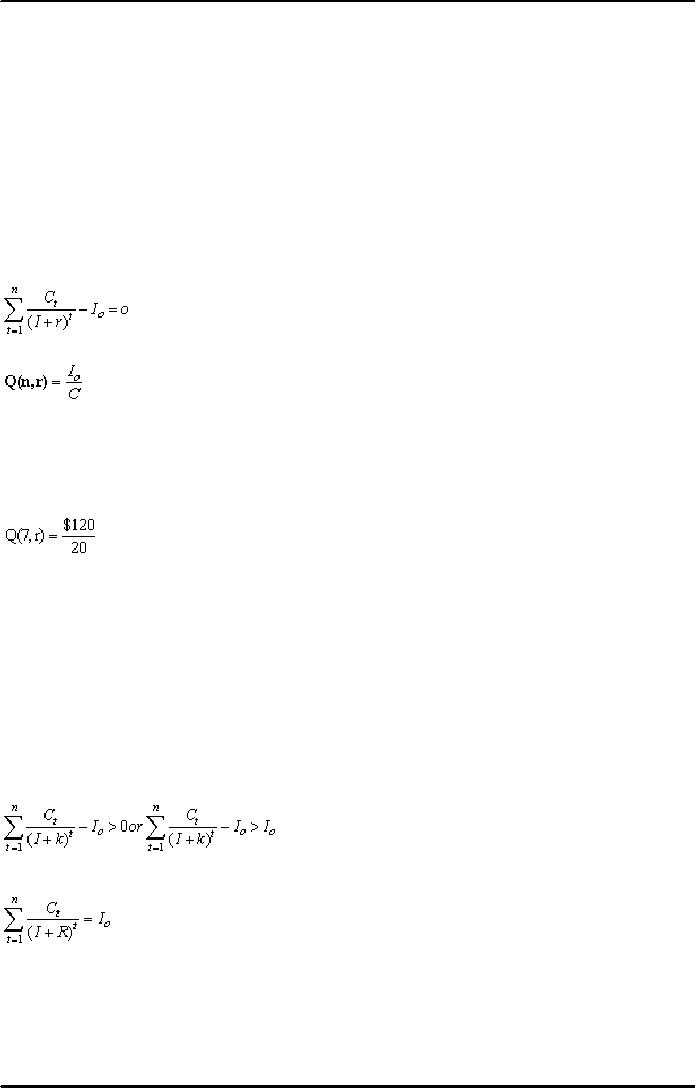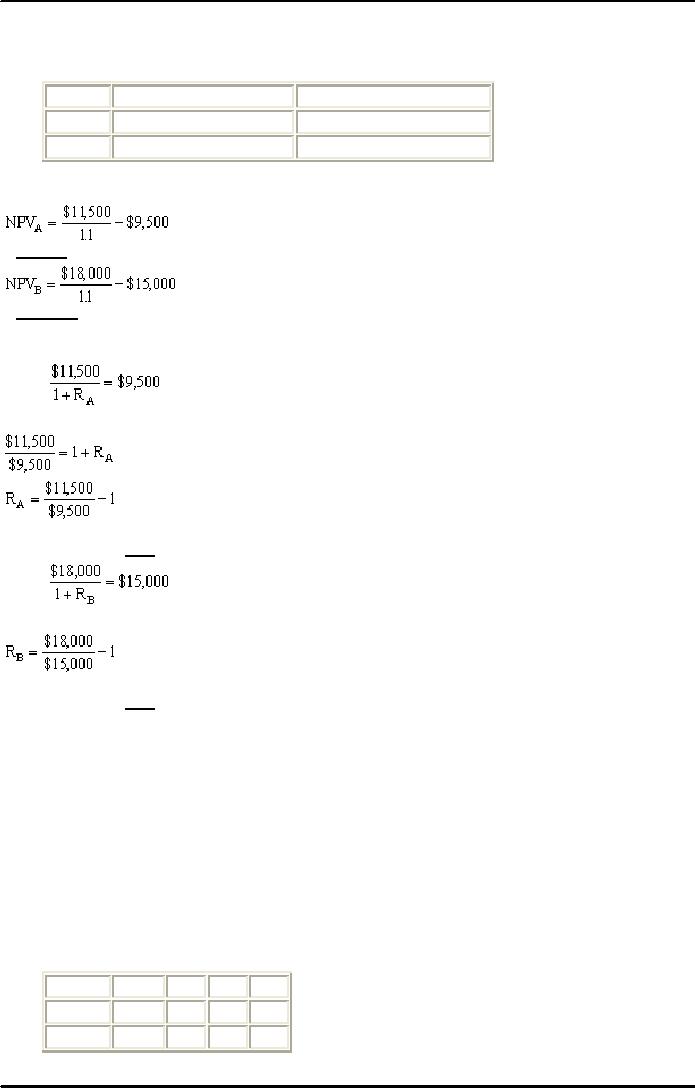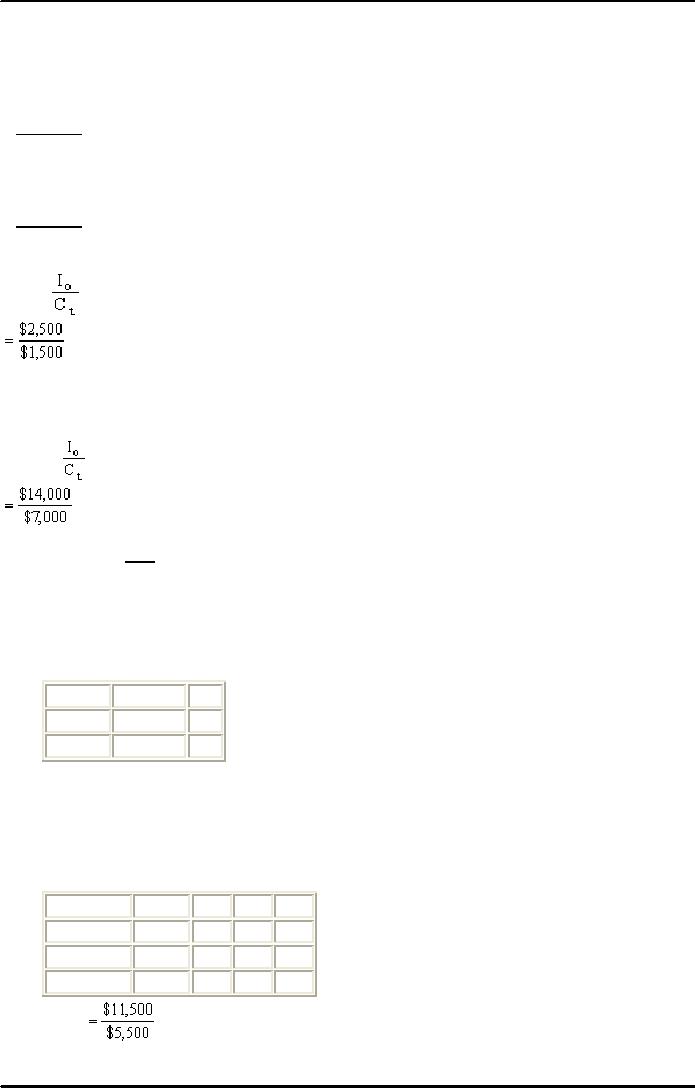 |
METHODS OF PROJECT EVALUATIONS 2 |
| << METHODS OF PROJECT EVALUATIONS, Net present value, Weighted Average Cost of Capital |
| METHODS OF PROJECT EVALUATIONS 3 >> |

Corporate
Finance FIN 622
VU
Lesson
10
METHODS
OF PROJECT EVALUATIONS
The
following topics will be
discussed in this hand out.
Methods
of Project evaluations:
Internal
Rate of Return IRR
Associated
topics to be covered:
NPV
vs. IRR
Criticism of
IRR
The
Internal Rate of Return
(IRR)
The
IRR is the discount rate at which the
NPV for a project equals
zero. This rate means that
the present
value
of the cash inflows for the
project would equal the
present value of its
outflows.
The
IRR is the break-even discount
rate.
The
IRR is found by trial and
error.
Where
r = IRR
IRR of
an annuity:
Where:
Q
(n, r) is the discount
factor
Io is the
initial outlay
C
is
the uniform annual receipt (C1 = C2 =....= Cn).
Example:
What
is the IRR of an equal annual
income of $20 per annum
which accrues for 7 years
and costs $120?
=6
Net
present value vs. Internal
rate of return:
Independent
vs. dependent
projects
NPV
and IRR methods are
closely related
because:
i)
both
are time-adjusted measures of
profitability, and
ii)
Their
mathematical formulas are almost
identical.
So,
which method leads to an
optimal decision: IRR or
NPV?
a) NPV
vs. IRR: Independent
projects
Independent
project: Selecting one project
does not preclude the
choosing of the other.
With
conventional cash flows (-|+|+) no
conflict in decision arises; in this
case both NPV and
IRR lead to
the
same accept/reject decisions.
Mathematical
proof: for a project to be
acceptable, the NPV must be positive,
i.e.
Similarly
for the same project to be
acceptable:
Where
R
is
the IRR.
Since
the numerators Ct
are identical
and positive in both
instances:
*
Implicitly/intuitively R must be greater
than k (R > k);
* If
NPV = 0 then R = k: the company is
indifferent to such a project;
*
Hence, IRR and NPV
lead to the same decision in this
case.
b) NPV
vs. IRR: Dependent
projects
NPV
clashes with IRR where
mutually exclusive projects
exist.
29

Corporate
Finance FIN 622
VU
Example:
Agritex
is considering building either a
one-storey (Project A) or five-storey (Project B)
block of offices on a
prime
site. The following
information is available:
Initial
Investment Outlay Net Inflow at
the Year End
Project A
-9,500
11,500
Project B
-15,000
18,000
Assume
k = 10%, which project should
Agritex undertake?
=
$954.55
=
$1,363.64
Both
projects are of one-year
duration:
IRRA:
$11,500
= $9,500 (1 +RA)
=
1.21-1
Therefore
IRRA =
21%
IRRB:
$18,000
= $15,000(1 + RB)
=
1.2-1
Therefore
IRRB =
20%
Decision:
Assuming
that k = 10%, both projects
are acceptable
because:
NPVA and NPVB
are
both positive
IRRA > k AND IRRB >
k
Which
project is a "better option"
for Agritex?
If we
use the NPV method:
NPVB ($1,363.64) > NPVA ($954.55): Agritex should
choose Project B.
If we
use the IRR method:
IRRA (21%) > IRRB (20%): Agritex should choose
Project A.
Differences
in the scale of
investment
NPV
and IRR may give conflicting
decisions where projects
differ in their scale of investment.
Example:
Years
0
1
2
3
Project A
-2,500 1,500 1,500
1,500
Project B
-14,000 7,000 7,000
7,000
30

Corporate
Finance FIN 622
VU
Assume
k= 10%.
NPVA =
$1,500 x PVFA at 10% for 3
years
=
$1,500 x 2.487
=
$3,730.50 - $2,500.00
=
$1,230.50.
NPVB ==
$7,000 x PVFA at 10% for 3
years
=
$7,000 x 2.487
=
$17,409 - $14,000
=
$3,409.00.
IRRA =
=
1.67.
Therefore
IRRA = 36%
(from the tables)
IRRB =
=
2.0
Therefore
IRRB =
21%
Decision:
Conflicting,
as:
· NPV
prefers B to A
· IRR
prefers A to B
NPV
IRR
Project A $
3,730.50 36%
Project B
$17,400.00 21%
To
show why:
i)
The
NPV prefers B, the larger project,
for a discount rate below
20%
ii)
The
NPV is superior to the IRR
a) Use
the incremental cash flow
approach, "B minus A"
approach
b)
Choosing project B is tantamount to
choosing a hypothetical project "B
minus A".
0
1
2
3
Project
B
-
14,000 7,000 7,000
7,000
Project
A
-
2,500 1,500 1,500
1,500
"B
minus A" - 11,500 5,500
5,500 5,500
IRR"B Minus A"
=
2.09
31

Corporate
Finance FIN 622
VU
=
20%
c)
Choosing B is equivalent to: A + (B - A) =
B
d)
Choosing the bigger project B
means choosing the smaller
project A plus an additional
outlay of
$11,500
of which $5,500 will be
realized each year for the
next 3 years.
e) The
IRR"B minus A"
on the incremental
cash flow is 20%.
f)
Given k of 10%, this is a profitable
opportunity, therefore must be
accepted.
g)
But, if k were greater than
the IRR (20%) on the incremental CF,
then reject project.
h) At the
point of intersection,
NPVA = NPVB or NPVA - NPVB
= 0, i.e.
indifferent to projects A and
B.
i) If k = 20%
(IRR of "B - A") the company should
accept project A.
This
justifies the use of NPV
criterion.
Advantage
of NPV:
It
ensures that the firm
reaches an optimal scale of
investment.
Disadvantage
of IRR:
· It
expresses the return in a percentage
form rather than in terms of
absolute dollar returns,
e.g. the
IRR
will prefer 500% of $1 to 20% return on
$100. However, most
companies set their goals
in
absolute
terms and not in % terms,
e.g. target sales figure of
$2.5 million.
The
timing of the cash
flow
The
IRR may give conflicting
decisions where the timing of
cash flows varies between
the 2 projects.
Note
that initial outlay Io is the same.
0
1
2
Project
A
- 100
20
125.00
Project
B
- 100
100
31.25
"A
minus B" 0
- 80
88.15
Assume
k = 10%
NPV
IRR
Project
A
17.3
20.0%
Project
B
16.7
25.0%
"A
minus B" 0.6
10.9%
IRR
prefers B to A even though
both projects have identical
initial outlays. So, the
decision is to accept A,
that
is B + (A - B) = A.
The horizon
problem
NPV
and IRR rankings are
contradictory. Project A earns $120 at the
end of the first year while
project B
earns
$174 at the end of the fourth
year.
0
1
2
3
4
Project
A
-100
120 -
-
-
Project
B
-100
-
-
-
174
Assume
k = 10%
32

Corporate
Finance FIN 622
VU
NPV
IRR
Project A
9
20%
Project B
19
15%
Decision:
NPV
prefers B to A.
IRR
prefers A to B.
33
Table of Contents:
- INTRODUCTION TO SUBJECT
- COMPARISON OF FINANCIAL STATEMENTS
- TIME VALUE OF MONEY
- Discounted Cash Flow, Effective Annual Interest Bond Valuation - introduction
- Features of Bond, Coupon Interest, Face value, Coupon rate, Duration or maturity date
- TERM STRUCTURE OF INTEREST RATES
- COMMON STOCK VALUATION
- Capital Budgeting Definition and Process
- METHODS OF PROJECT EVALUATIONS, Net present value, Weighted Average Cost of Capital
- METHODS OF PROJECT EVALUATIONS 2
- METHODS OF PROJECT EVALUATIONS 3
- ADVANCE EVALUATION METHODS: Sensitivity analysis, Profitability analysis, Break even accounting, Break even - economic
- Economic Break Even, Operating Leverage, Capital Rationing, Hard & Soft Rationing, Single & Multi Period Rationing
- Single period, Multi-period capital rationing, Linear programming
- Risk and Uncertainty, Measuring risk, Variability of return–Historical Return, Variance of return, Standard Deviation
- Portfolio and Diversification, Portfolio and Variance, Risk–Systematic & Unsystematic, Beta – Measure of systematic risk, Aggressive & defensive stocks
- Security Market Line, Capital Asset Pricing Model – CAPM Calculating Over, Under valued stocks
- Cost of Capital & Capital Structure, Components of Capital, Cost of Equity, Estimating g or growth rate, Dividend growth model, Cost of Debt, Bonds, Cost of Preferred Stocks
- Venture Capital, Cost of Debt & Bond, Weighted average cost of debt, Tax and cost of debt, Cost of Loans & Leases, Overall cost of capital – WACC, WACC & Capital Budgeting
- When to use WACC, Pure Play, Capital Structure and Financial Leverage
- Home made leverage, Modigliani & Miller Model, How WACC remains constant, Business & Financial Risk, M & M model with taxes
- Problems associated with high gearing, Bankruptcy costs, Optimal capital structure, Dividend policy
- Dividend and value of firm, Dividend relevance, Residual dividend policy, Financial planning process and control
- Budgeting process, Purpose, functions of budgets, Cash budgets–Preparation & interpretation
- Cash flow statement Direct method Indirect method, Working capital management, Cash and operating cycle
- Working capital management, Risk, Profitability and Liquidity - Working capital policies, Conservative, Aggressive, Moderate
- Classification of working capital, Current Assets Financing – Hedging approach, Short term Vs long term financing
- Overtrading – Indications & remedies, Cash management, Motives for Cash holding, Cash flow problems and remedies, Investing surplus cash
- Miller-Orr Model of cash management, Inventory management, Inventory costs, Economic order quantity, Reorder level, Discounts and EOQ
- Inventory cost – Stock out cost, Economic Order Point, Just in time (JIT), Debtors Management, Credit Control Policy
- Cash discounts, Cost of discount, Shortening average collection period, Credit instrument, Analyzing credit policy, Revenue effect, Cost effect, Cost of debt o Probability of default
- Effects of discounts–Not effecting volume, Extension of credit, Factoring, Management of creditors, Mergers & Acquisitions
- Synergies, Types of mergers, Why mergers fail, Merger process, Acquisition consideration
- Acquisition Consideration, Valuation of shares
- Assets Based Share Valuations, Hybrid Valuation methods, Procedure for public, private takeover
- Corporate Restructuring, Divestment, Purpose of divestment, Buyouts, Types of buyouts, Financial distress
- Sources of financial distress, Effects of financial distress, Reorganization
- Currency Risks, Transaction exposure, Translation exposure, Economic exposure
- Future payment situation – hedging, Currency futures – features, CF – future payment in FCY
- CF–future receipt in FCY, Forward contract vs. currency futures, Interest rate risk, Hedging against interest rate, Forward rate agreements, Decision rule
- Interest rate future, Prices in futures, Hedging–short term interest rate (STIR), Scenario–Borrowing in ST and risk of rising interest, Scenario–deposit and risk of lowering interest rates on deposits, Options and Swaps, Features of opti
- FOREIGN EXCHANGE MARKET’S OPTIONS
- Calculating financial benefit–Interest rate Option, Interest rate caps and floor, Swaps, Interest rate swaps, Currency swaps
- Exchange rate determination, Purchasing power parity theory, PPP model, International fisher effect, Exchange rate system, Fixed, Floating
- FOREIGN INVESTMENT: Motives, International operations, Export, Branch, Subsidiary, Joint venture, Licensing agreements, Political risk